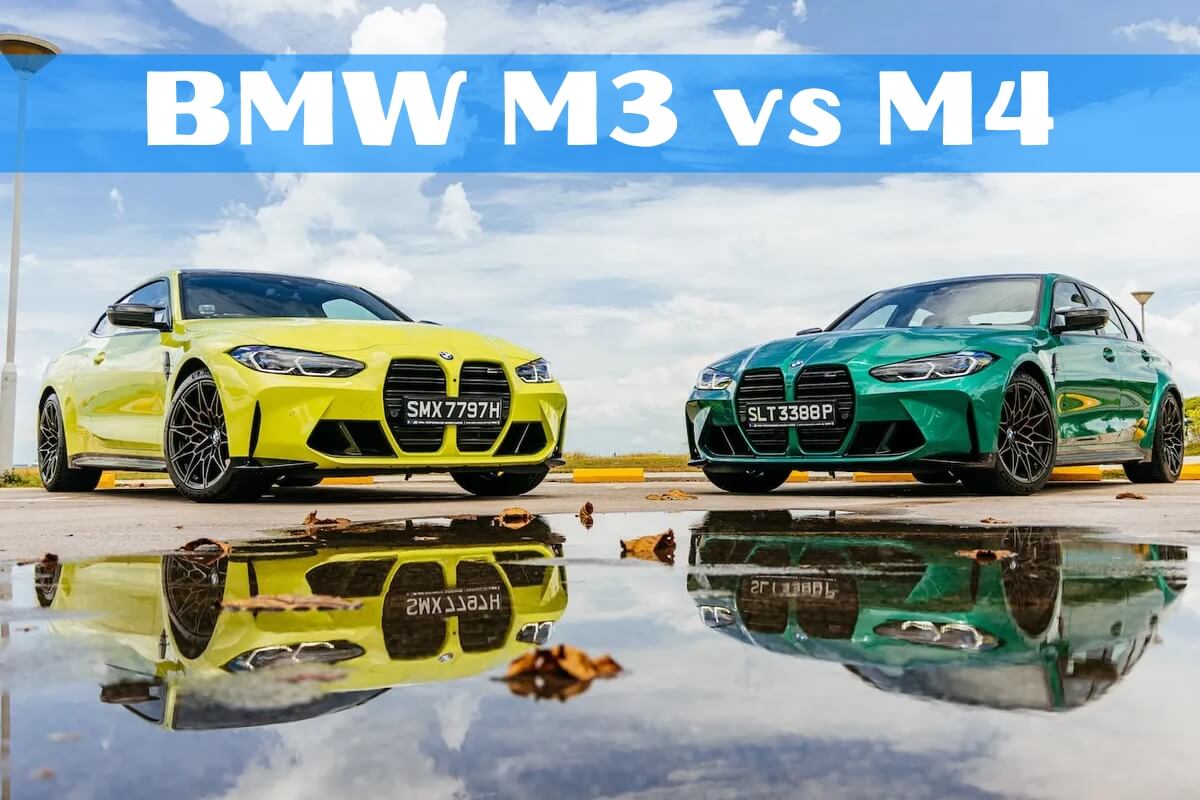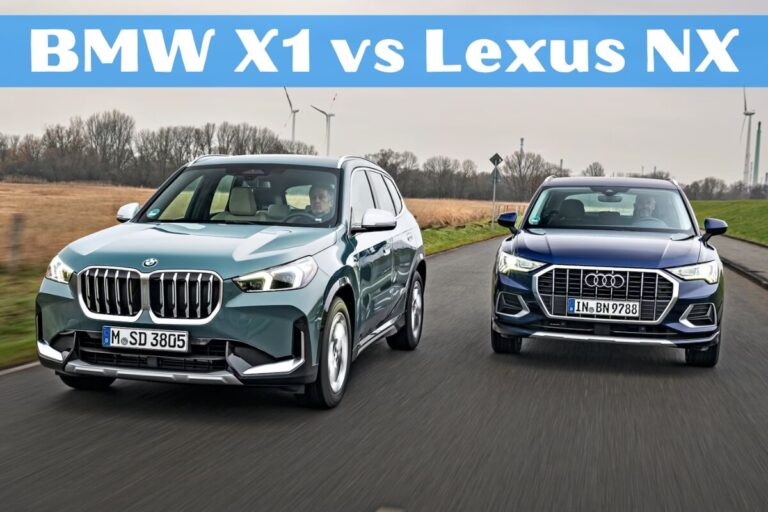BMW M3 vs M4: Unleashing the Ultimate Driving Thrill

Are you torn between the BMW M3 and M4? Both are adrenaline-fueled, high-performance sports cars that promise an exhilarating driving experience. But which one should you choose? In this detailed comparison, we’ll dive deep into their key differences to help you make an informed decision.
The BMW M3 is a powerful sports sedan, while the BMW M4 is a sleek and stylish coupe version. Both pack a ferocious punch under the hood and deliver lightning-quick acceleration. However, they differ in design, practicality, and driving dynamics.
This post covers everything you need to know about these German performance icons. From styling and engine specs to handling and interior space, we’ll leave no stone unturned. We’ll also explore their pricing, trim levels, and unique advantages to help you choose the perfect fit.
Design and Styling: Sedan vs Coupe Athleticism
The BMW M3 and M4 share the same aggressive, muscular styling cues that scream performance. However, their body styles create a distinct visual difference.
The M3 is a sports sedan with four doors and a trunk, while the M4 is a sleek, low-slung coupe with two doors and a more rakish roofline. Both feature BMW’s signature kidney grille and sculpted body lines, but the M4’s coupe profile gives it a slightly more athletic, aerodynamic stance.
Inside, the cabins are nearly identical, with premium materials, supportive sport seats, and an intuitive control layout. However, the M3’s extra set of doors and roomier back seat make it more practical for carrying passengers.
Blistering Performance for the Racetrack or Street
Under the hood, both the M3 and M4 pack a ferocious 3.0-liter twin-turbocharged inline-six engine. In the United States, this powerplant churns out 473 horsepower and 406 lb-ft of torque in the base models.
Opt for the Competition versions, and you’ll enjoy a boost to 503 hp – more than enough to pin you back in your seat. Both cars feature rear-wheel drive or BMW’s xDrive all-wheel drive system for superior traction.
When it comes to transmissions, you can choose between a slick-shifting six-speed manual or an ultra-quick eight-speed automatic. With the auto and xDrive, the M3 and M4 can rocket from 0-60 mph in around 3.5 heart-pounding seconds.
Despite their potent performance, the M3 and M4 still manage respectable fuel economy for their class. You can expect around 16 mpg city and 23 mpg highway with the automatic transmission.
Driving Dynamics: A Tale of Two Chassis
While the M3 and M4 share most of their mechanical components, their chassis setups create distinct driving characteristics. The M4’s lower center of gravity and more balanced weight distribution give it a slight edge in agility and steering response.
However, the M3 is no slouch, delivering razor-sharp handling and immense grip. Both cars feature adaptive suspension dampers that can switch between a comfortable street setting and a track-ready sport mode.
BMW’s rear-biased xDrive AWD system also enhances traction while still allowing enough rear slip for thrilling powerslides when you desire. An electronic limited-slip differential and massive cross-drilled brakes ensure optimum control.
When it comes to driver assistance tech, the M3 and M4 offer blind-spot monitoring, adaptive cruise control, and forward collision warning. But the focus here is squarely on uncompromising performance driving.
As a sedan, the BMW M3 understandably offers more interior room and practicality than the two-door M4 coupe. Larger rear doors make entry/exit easier, and there’s more headroom and legroom for rear passengers.
Space and Practicality: The Advantage of Four Doors
The M3 also provides 13 cubic feet of trunk space compared to 10.8 cubes for the M4. Folding rear seats boost cargo flexibility in both models.
However, the M4’s coupe design gives it a slight advantage in outward visibility, with slimmer pillars and a lower belt line. But overall, the M3 is better suited for those needing occasional rear passenger room or extra cargo-hauling ability.
Pricing and Trims: From Accessible to Luxury Status Symbol
The 2023 BMW M3 starts at $73,795, while the M4 coupe commands $74,995 with rear-wheel drive. Adding xDrive AWD is a $4,100 premium on both cars.
From there, you can step up to the blistering M3 Competition xDrive at $83,895 or the M4 Competition xDrive at $86,495. These top-tier performance trims add more power, upgraded brakes, and aesthetic enhancements.
You can further personalize the M3 and M4 with optional packages like the Executive Package (heated seats, head-up display), Track Package (upgraded cooling and chassis components), and Parking Assistance Package.
When it comes to resale value, BMWs typically hold their worth better than average thanks to their premium brand cachet. The M3 and M4 should fare well in this regard, though some depreciation is inevitable for high-performance vehicles.
The M3 Advantage: A Performance Sedan Without Compromise
The BMW M3 gives you the best of both worlds: scorching performance and real-world practicality. Its spacious cabin and ample trunk space make it suitable for daily driving duties, road trips, or hauling sports gear.
At the same time, the M3 delivers the thrilling acceleration, razor-sharp reflexes, and track-ready chassis expected from a BMW M car. It allows you to enjoy supercar performance without the compromises of a two-seater.
If you want pulse-pounding performance with a dose of pragmatism, the M3 could be your perfect companion. It’s the consummate all-rounder in BMW’s performance lineup.
The M4 Advantage: A Purebred Sports Car with Stunning Coupe Style
While the M3 tries to be all things to all people, the BMW M4 coupe is a no-compromises performance machine. Its low-slung, two-door body and ideal 50/50 weight distribution give it an edge in outright handling prowess.
The M4’s coupe profile also looks wildly more dynamic and athletic than the sedan M3. It makes a bolder visual statement while still offering generous trunk space for a weekend’s worth of gear.
If you don’t need the M3’s extra doors and rear seats, the M4 could be the sharper driving instrument and head-turning style icon. It’s the purist’s choice for those who view practicality as secondary to ultimate driving thrills.
Head-to-Head: How the M3 and M4 Compare
To help visualize how the BMW M3 and M4 stack up, here’s a side-by-side comparison of their key specifications:
- 0-60 mph: 3.5 seconds (Competition xDrive)
- Horsepower: 473 hp (base), 503 hp (Competition)
- Torque: 406 lb-ft (both models)
- Curb weight: 3,850 lbs (M3), 3,830 lbs (M4)
- EPA combined MPG: 19 mpg (base RWD), 18 mpg (xDrive)
- Cargo space: 13.0 cu-ft (M3), 10.8 cu-ft (M4)
- Rear legroom: 35.7 inches (M3), 31.9 inches (M4)
- Starting MSRP: $73,795 (M3), $74,995 (M4)
As you can see, the core performance metrics are nearly identical. The M3 has a slight edge in cargo room and rear passenger space, while the M4 is lighter and more aerodynamic.
The Verdict: Which One Reigns Supreme?
Both the BMW M3 and M4 are world-class performance machines that deliver hair-raising acceleration and handling prowess. But which one should you crown as the ultimate Bavarian speed king?
The M4’s low-slung coupe design gives it a very slight advantage in driving dynamics and steering response. Its sleek, two-door profile is also more visually arresting than the M3 sedan.
However, the M3 is the more well-rounded and livable daily driver thanks to its extra set of doors, roomier cabin, and useful trunk space






